Soil Organic Carbon Dynamics in Semi-Arid Irrigated Cropping Systems
Abstract
1. Introduction
2. Materials and Methods
2.1. Sites
2.2. Calibration Data
2.3. DNDC
2.4. Forecasting
2.5. Statistical Analysis
3. Results and Discussion
3.1. Annual SOC Stocks
3.2. Average Rate of Change
3.3. Specific Management Questions
3.4. DNDC Modeling
3.5. DNDC Model Forecasting
4. Conclusions
Supplementary Materials
Author Contributions
Funding
Acknowledgments
Conflicts of Interest
References
- IPCC. Climate Change and Land: An IPCC Special Report on Climate Change, Desertification, Land Degradation, Sustainable Land Management, Food Security, and Greenhouse Gas Fluxes in Terrestrial Ecosystems; Shukla, P.R., Skea, J., Buendia, E.C., Masson-Delmotte, V., Pörtner, H.-O., Roberts, D.C., Zhai, P., Slade, R., Connors, S., van Diemen, R., et al., Eds.; IPCC: Geneva, Switzerland, 2019; in press. [Google Scholar]
- Luo, Z.; Feng, W.; Luo, Y.; Baldock, J.; Wang, E. Soil organic carbon dynamics jointly controlled by climate, carbon inputs, soil properties and soil carbon fractions. Global Chang. Biol. 2017, 23, 4430–4439. [Google Scholar] [CrossRef]
- Powers, J.S.; Schlesinger, W.H. Relationships among soil carbon distributions and biophysical factors at nested spatial scales in rain forests of northeastern Costa Rica. Geoderma. 2002, 109, 165–190. [Google Scholar] [CrossRef]
- Haile, S.G. Soil Carbon Sequestration and Stabilization in Tree-Based Pasture Systems in Florida. Ph.D. Thesis, University of Florida, Gainesville, FL, USA, 2007. [Google Scholar]
- Takimoto, A.; Nair, P.K.R.; Nair, V.D. Carbon stock and sequestration potential of traditional and improved agroforestry systems in the west African Sahel. Agric. Ecosyst. Environ. 2008, 125, 159–166. [Google Scholar] [CrossRef]
- Carvalhais, N.; Forkel, M.; Khomik, M.; Bellarby, J.; Jung, M.; Migliavacca, M.; Mu, M.; Saatchi, S.; Santoro, M.; Thurner, M.; et al. Global covariation of carbon turnover times with climate in terrestrial ecosystems. Nature 2014, 514, 213–217. [Google Scholar] [CrossRef] [PubMed]
- Jenkinson, D.S. The Rothamsted long-term experiments: Are they still of use? Agron. J. 1991, 83, 2–10. [Google Scholar] [CrossRef]
- Halvorson, A.D.; Reule, C.A.; Follett, R.F. Nitrogen fertilization effects on soil carbon and nitrogen in a dryland cropping system. Soil Sci. Soc. Am. J. 1999, 63, 912–917. [Google Scholar] [CrossRef]
- Follett, R.F. Soil management concepts and carbon sequestration in cropland soils. Soil Till. Res. 2001, 61, 77–92. [Google Scholar] [CrossRef]
- Lal, R.; Kimble, J.M. Pedogenic carbonates and the global carbon cycle. In Global Climate Change and Pedogenic Carbonates; Lal, R., Kimble, J.M., Eswaran, H., Stewart, B.A., Eds.; CRC Press: Boca Raton, FL, USA, 2000; pp. 1–14. [Google Scholar]
- Martens, D.A.; Emmerich, W.; McLain, J.E.T.; Johnsen, T.N. Atmospheric carbon mitigation potential of agricultural management in the southwestern USA. Soil Till. Res. 2005, 83, 95–119. [Google Scholar] [CrossRef]
- Peel, M.C.; Finlayson, B.L.; McMahon, T.A. Updated world map of the Koppen-Geiger climate classification. Hydrol. Earth Syst. Sci. 2007, 11, 1633–1644. [Google Scholar] [CrossRef]
- Ghimire, R.; Machado, S.; Rhinhart, K. Long-term crop residue and nitrogen management effects on soil profile carbon and nitrogen in wheat-fallow systems. Agron. J. 2015, 107, 2230–2240. [Google Scholar] [CrossRef]
- Ghimire, R.; Machado, S.; Bista, P. Soil ph, soil organic matter, and crop yields in winter wheat-summer fallow systems. Agron. J. 2017, 109, 706–717. [Google Scholar] [CrossRef]
- Huber, D.P.; Lohse, K.A.; Commendador, A.; Joy, S.; Aho, K.; Finney, B.; Germino, M.J. Vegetation and precipitation shifts interact to alter organic and inorganic carbon storage in cold desert soils. Ecosphere 2019, 10, e02655. [Google Scholar] [CrossRef]
- Williams, J.R.; Jones, C.A.; Dyke, P.T. A modeling approach to determining the relationship between erosion and soil productivity. T. ASABE 1984, 27, 129–144. [Google Scholar] [CrossRef]
- Coleman, K.; Jenkinson, D.S. Rothc–26.3—A model for the turnover of carbon in soil. In. Evaluation of Soil Organic Matter Models Using Existing Long-Term Datasets; Powlson, D.S., Smith, P., Smith, J.U., Eds.; Springer: Berlin/Heidelberg, Germany, 1996. [Google Scholar] [CrossRef]
- Li, C. The dndc model. In Evaluation of Soil Organic Matter Models; Powlson, D.S., Smith, P., Smith, J.U., Eds.; Springer: Berlin/Heidelberg, Germany, 1996; pp. 263–268. [Google Scholar]
- Del Grosso, S.J.; Parton, W.J.; Mosier, A.R.; Hartman, M.D.; Keough, C.A.; Peterson, G.A.; Ojima, D.S.; Schimel, D.S. Simulated effects of land use, soil texture, and precipitation on N gas emissions using daycent. In Nitrogen in the Environment: Sources, Problems, and Management; Follet, R.F., Hatfield, J.L., Eds.; Elsevier: Amsterdam, The Netherlands, 2001; pp. 413–431. [Google Scholar]
- Ma, L.; Ahuja, L.R.; Nolan, B.T.; Malone, R.W.; Trout, T.J.; Qi, Z. Rootzone water quality model (rzwqm2): Model use, calibration, and validation. T. ASABE. 2012, 55, 1425–1446. [Google Scholar] [CrossRef]
- Institute for the Study of Earth, Ocean, and Space. The DNDC Model. Version 9.5. University of New Hampshire. Durham, NH 03824. 2012. Available online: www.dndc.sr.unh.edu (accessed on 1 October 2019).
- Gilhespy, S.L.; Anthony, S.; Cardenas, L.; Chadwick, D.; del Prado, A.; Li, C.; Misselbrook, T.; Rees, R.M.; Salas, W.; Sanz-Cobena, A.; et al. Fist 20 years of dndc (denitrification decomposition): Model evaluation. Ecol. Model. 2014, 292, 51–62. [Google Scholar] [CrossRef]
- Bierer, A.M.; Leytem, A.B.; Rogers, C.W.; Dungan, R.S. Evaluation of a microplate spectrophotometer for soil organic carbon determination in south central Idaho. Soil Sci. Soc. Am. J. 2020. [Google Scholar] [CrossRef]
- University of Idaho Extension. University of Idaho. Available online: https://www.uidaho.edu/extension (accessed on 3 March 2021).
- Leytem, A.B.; Moore, A.D.; Dungan, R.S. Greenhouse gas emissions from an irrigated crop rotation utilizing dairy manure. Soil Soc. Am. J. 2019, 83, 137–152. [Google Scholar] [CrossRef]
- Dungan, R.S.; Leytem, A.B.; Tarkalson, D.D.; Ippolitio, J.A.; Bjorneberg, D.L. Greenhouse gas emissions from an irrigated dairy forage rotation as influenced by fertilizer and manure applications. Soil Sci. Soc. Am. J. 2017, 81, 537–545. [Google Scholar] [CrossRef]
- Souza, D.M.; Morais, P.A.O.; Matsushige, I.; Rosa, L.A. Development of alternative methods for determining soil organic matter. Rev. Bras. Cienc. Solo. 2016, 40. [Google Scholar] [CrossRef]
- Walkley, A.; Black, I.A. An examination of the degtjareff method for determining soil organic matter, and a proposed modification of the chromic acid titration method. Soil Sci. 1934, 37, 29–38. Available online: https://journals.lww.com (accessed on 1 October 2019). [CrossRef]
- Westermann, D.T.; Crothers, S.E. Measuring soil nitrogen mineralization under field conditions. Agron. J. 1980. [Google Scholar] [CrossRef]
- Hofer, S. Determination of Ammonia (Salicylate) in 2MKCl Soil Extracts by Flow Injection Analysis; QuickChem Method 12-107-06-2-A; Revised by K. Bogren 2003; Lachat Instruments: Loveland, CO, USA, 2001. [Google Scholar]
- Knepel, K. Determination of Nitrate in 2MKCl Soil Extracts by Flow Injection Analysis; QuickChem Method 12-107-04-1-B. Revised by K. Bogren 2003; Lachat Instruments: Loveland, CO, USA, 2001. [Google Scholar]
- Robison, C.W.; Allen, R.G. ETIdaho update through 2015—ETIdaho 2016; Idaho Department of Water Resources, University of Idaho: Moscow, ID, USA, 2017. [Google Scholar]
- Allen, R.G.; Robison, C.W.; Huntingtion, J.; Wright, J.L.; Kilic, A. Applying the FAO56 dual kc method for irrigation water requirements over large areas in the USA. Trans. ASABE 2020, 63, 1–23. [Google Scholar] [CrossRef]
- Van Liew, M.W.; Garbrecht, J. Hydrologic simulation of the little washita river experimental watershed using swat. JAWRA 2003, 39, 413–426. [Google Scholar] [CrossRef]
- Li, C. Steps for Calibration and Validation of DNDC. 2013. Available online: https://www.arb.ca.gov/cc/capandtrade/protocols/rice/steps-for-dndc-12-20-13.pdf (accessed on 1 May 2020).
- NOAA, National Centers for Environmental Information, State Summaries, 149-ID. 2019. Available online: www.ncei.noaa.gov (accessed on 10 October 2020).
- R Core Team. R: A Language and Environment for Statistical Computing; R Foundation for Statistical Computing: Vienna, Austria, 2020; Available online: https://www.R-project.org/ (accessed on 1 October 2019).
- Peterson, R.A.; Cavanaugh, J.E. Ordered quantile normalization: A semiparametric transformation built for the cross-validation era. J. Appl. Stat. 2019. [Google Scholar] [CrossRef]
- Mendiburu, F. “Agricolae”. Statistical Procedures for Agricultural Research; National University of Engineering: Lima, Peru, 2020; Available online: cran.r-project.org (accessed on 1 October 2019).
- Bates, D.; Maechler, M.; Bolker, B.; Walker, S.; Christensen, R.H.B.; Singmann, H.; Dai, B.; Scheipl, F.; Grothendieck, G.; Green, P.; et al. ‘lme4’. 2020. Available online: cran.r-project.org (accessed on 1 October 2019).
- Kemper, W.D.; Trout, T.J.; Brown, M.J.; Rosenau, R.C. Furrow erosion and water and soil management. Trans. ASAE. 1985, 28, 1564–1572. Available online: nwisrl.ars.usda.gov (accessed on 1 October 2020). [CrossRef]
- Trout, T.; Carter, D.; Sojka, B. Irrigation-induced soil erosion reduces yields and muddies rivers. Irrig. J. 1994, 44, 11–12. Available online: nwisrl.ars.usda.gov (accessed on 1 October 2020).
- Beck, T. Einfluss langjähriger monokultur auf die bodenbelebung im vergleich zur fruchtfolge. Landwirtsch. Forschung Sonderh. 1975, 31, 268–276. [Google Scholar]
- Steinbrenner, K.; Smukalski, M. Einfluss von anbaustruktur und fruchtfolge auf einige bodeneigenschaften, dargestellt an ergebnissen des Internationalen fruchtfolgeversuches dewitz. Arch. Agron. Soil Sci. 1984, 28, 611–616. [Google Scholar]
- Grandy, A.S.; Porter, G.A.; Erich, M.S. Organic amendment and rotation crop effects on the recovery of soil organic matter and aggregation in potato cropping systems. Soil Sci. Soc. Am. J. 2002, 66, 1311–1319. [Google Scholar] [CrossRef]
- Gradziuk, P.; Gradziuk, B.; Trocewicz, A.; Jendrzejewski, B. Potential of straw for energy purposes in Poland—forecasts based on trend and causal models. Energies 2020, 13, 5054. [Google Scholar] [CrossRef]
- Franzluebbers, A.J.; Stuedemann, J.A.; Wilkinson, S.R. Bermudagrass management in the southern piedmont USA. Soil Sci. Soc. Am. J. 2001, 65, 834–841. [Google Scholar] [CrossRef]
- Kanaujia, V.K. Effect of fym and fertilizers nutrition on production potential, nutrients uptake and soil properties under rice-wheat cropping system. JAS 2016, 3, 101–105. Available online: https://www.jsure.org.in (accessed on 1 October 2019). [CrossRef]
- Jesus, K.N.D.; Menezes, R.S.C.; Filho, R.N.D.A.; Sampaio, E.V.D.S.B.; Antonino, A.C.D.; Primo, D.C. Maize and sunflower yields and soil changes after five years of organic fertilization in the semi-arid region of Paraiba, Brazil. Arid Land Res. Manag. 2020, 34, 460–473. [Google Scholar] [CrossRef]
- Clapp, C.E.; Allmaras, R.R.; Layese, M.F.; Linden, D.R.; Dowdy, R.H. Soil organic carbon and 13C abundance as related to tollage, crop residue, and nitrogen fertilization under continuous corn management in Minnesota. Soil Tillage Res. 2000, 55, 127–142. [Google Scholar] [CrossRef]
- McCallister, D.L.; Chien, W.L. Organic carbon quantity and forms as influenced by tillage and cropping sequence. Commun. Soil Sci. Plant Anal. 2000, 31, 465–479. [Google Scholar] [CrossRef]
- Varvel, G.E.; Wilhelm, W.W. Long-term soil organic carbon as affected by tillage and cropping systems. Soil Sci. Soc. Am. J. 2010, 74, 915–921. [Google Scholar] [CrossRef]
- Xu, H.; Sieverding, H.; Kwon, H.; Clay, D.; Stewart, C.; Johnson, J.M.F.; Qin, Z.; Karlen, D.L.; Wang, M. A global meta-analysis of soil organic carbon response to corn stover removal. GCB Bioenergy 2019, 11, 1215–1233. [Google Scholar] [CrossRef]
- Bolinder, M.A.; Angers, D.A.; Giroux, M.; Laverdiere, M.R. Estimating C inputs retained as soil organic matter from corn (zea mays l.). Plant Soil. 1999, 215, 85–91. [Google Scholar] [CrossRef]
- Coleman, K.; Jenkinson, D.S.; Crocker, G.J.; Grace, P.R.; Klir, J.; Korschens, M.; Poulton, P.R.; Richter, D.D. Simulating trends in soil organic carbon in long-term experiments using RothC–26.3. Geoderma 1997, 81, 29–44. [Google Scholar] [CrossRef]
- Moore, A.; Ippolito, J.A. Dairy Manure Field Applications-How much is too much? University of Idaho. College of Agricultural and Life Sciences. Extension Bulletin CIS1156. 2009. Available online: www.extension.uidaho.edu (accessed on 1 October 2020).
- Stewart, C.E.; Paustian, K.; Conant, R.T.; Plante, A.F.; Six, J. Soil carbon saturation: Concept, evidence and evaluation. Biogeochemistry 2007, 86, 19–31. Available online: oce.ovid.com (accessed on 1 October 2020). [CrossRef]
- Castellano, M.J.; Mueller, K.E.; Olk, D.C.; Sawyer, J.E.; Six, J. Integrating plant litter quality, soil organic matter stabilization, and the carbon saturation concept. Global Change Biol. 2015, 21, 3200–3209. [Google Scholar] [CrossRef] [PubMed]
- Bolinder, M.A.; Katterer, T.; Poeplau, C.; Borjesson, G.; Parent, L.E. Net primary productivity and below-ground crop residue inputs for root crops: Potato (solanum tuberosum l.) and sugar beet (beta vulgaris l.). Can. J. Soil Sci. 2015, 95, 87–93. [Google Scholar] [CrossRef]
- Moulin, A.P.; Buckley, K.E.; Volkmar, K. Soil quality as affected by amendments in pinto bean-potato rotations. Can. J. Soil Sci. 2011, 91, 533–542. [Google Scholar] [CrossRef]
- Miao, S.; Qiao, Y.; Yin, Y.; Jin, J.; Marten, B.; Liu, X.; Tang, C. Ten-year application of cattle manure contributes to the build-up of soil organic matter in eroded mollisols. J. Soils Sediments. 2019, 19, 3035–3043. [Google Scholar] [CrossRef]
- Luo, Z.; Wang, E.; Sun, O.J. Can no-tillage stimulate carbon sequestration in agricultural soils? A meta-analysis of paired experiments. Agric. Ecosyst. Environ. 2010, 139, 224–231. [Google Scholar] [CrossRef]
- West, T.O.; Post, W.M. Soil organic carbon sequestration rates by tillage and crop rotation, a global data analysis. Soil Sci. Soc. Am. J. 2002, 66, 1930–1946. [Google Scholar] [CrossRef]
- Angers, D.A.; Eriksen-Hamel, N.S. Full-inversion tillage and organic carbon distribution in soil profiles: A meta-analysis. Soil Sci. Soc. Am. J. 2008, 72, 1370–1374. [Google Scholar] [CrossRef]
- Aguilera, E.; Lassaletta, L.; Gattinger, A.; Gimeno, B. SManaging soil carbon for climate change mitigation and adaptation in Mediterranean cropping systems: A meta-analysis. Agric. Ecosyst. Environ. 2013, 168, 25–36. [Google Scholar] [CrossRef]
- Poeplau, C.; Don, A. Carbon sequestration in agricultural soils via cultivation of cover crops—A meta-analysis. Agric. Ecosyst. Environ. 2015, 200, 33–41. [Google Scholar] [CrossRef]
- Jian, J.; Du, X.; Reiter, M.S.; Stewart, R.D. A meta-analysis of global cropland soil carbon changes due to cover cropping. Soil Biol. Biochem. 2020, 143, 107735. [Google Scholar] [CrossRef]
- Bolinder, M.A.; Crotty, F.; Elsen, A.; Frac, M.; Kismanyoky, T.; Lipiec, J.; Tits, M.; Toth, Z.; Katterer, T. The effect of crop residues, cover crops, manures and nitrogen fertilization on soil organic carbon changes in agroecosystems: A synthesis of reviews. Mitig. Adapt. Strateg. Glob. Chang. 2020, 25, 929–952. [Google Scholar] [CrossRef]
- Lepsch, H.C.; Brown, P.H.; Peterson, C.A.; Gaudin, A.C.M.; Khalsa, S.D.S. Impact of organic matter amendments on soil and tree water status in a California orchard. Agric. Water Manag. 2019, 222, 204–212. [Google Scholar] [CrossRef]
- Ahmed, S.I.; Mickelson, S.K.; Pederson, C.H.; Baker, J.L.; Kanwar, R.S.; Lormir, J.C.; Webber, D.F. Swine manure rate, timing, and application method effects on post-harvest soil nutrients, crop yield, and potential water quality implications in a corn-soybean rotation. Trans. ASABE. 2013, 56, 395–408. [Google Scholar] [CrossRef]
- Maillard, E.; Angers, D.A. Animal manure application and soil organic carbon stocks: A meta-analysis. Global Change Biol. 2013, 20, 666–679. [Google Scholar] [CrossRef] [PubMed]
- Cherney, J.H.; Ketterings, Q.M.; Cherney, D.J.; Davis, M.H. Timing of semisolid dairy manure applications does not affect yield and quality of orchardgrass. Agron. J. 2010, 102, 553–558. [Google Scholar] [CrossRef]
- Randall, G.W.; Schmitt, M.A.; Schmidt, J.P. Corn production as affected by time and rate of manure application and nitrapyrin. J. Prod. Agric. 2013, 12, 317–323. [Google Scholar] [CrossRef]
- Bjorneberg, D.L.; King, B.A.; Koehn, A.C. Watershed water balance changes as furrow irrigation is converted to sprinkler irrigation in an arid region. J. Soil Water Conserv. 2020, 75, 254–262. [Google Scholar] [CrossRef]
- Morari, F.; Lugato, E.; Berti, A.; Giardini, L. Long-term effects of recommended management practices on soil carbon changes and sequestration in north-eastern Italy. Soil Use Manag. 2006, 22, 71–81. [Google Scholar] [CrossRef]
- Triberti, L.; Nastri, A.; Baldoni, G. Long-term effects of crop rotation, manure and mineral fertilization on carbon sequestration and soil fertility. Eur. J. Agron. 2016, 74, 47–55. [Google Scholar] [CrossRef]
- Eghball, B. Soil properties as influenced by phosphorous and nitrogen based manure and compost applications. Agron. J. 2002, 94, 128–135. [Google Scholar] [CrossRef]
- Li, C.; Salas, W.; Zhang, R.; Krauter, C.; Rotz, A.; Mitloehner, F. Manure-dndc: A biogeochemical process model for quantifying greenhouse has and ammonia emissions from livestock manure systems. Nutr. Cycl. Agroecosystems. 2012, 93, 163–200. [Google Scholar] [CrossRef]
- Li, S.; Li, J.; Li, C.; Huang, S.; Li, X.; Li, S.; Ma, Y. Testing the rothc and dndc models against long-term dynamics of soil organic carbon stock observed at cropping field soils in north China. Soil Tillage Res. 2016, 163, 290–297. [Google Scholar] [CrossRef]
- Zhang, J.; Hu, K.; Li, K.; Zheng, C.; Li, B. Simulating the effects of long-term discontinuous and continuous fertilization with straw return on crop yields and soil organic carbon dynamics using the dndc model. Soil Tillage Res. 2017, 165, 302–314. [Google Scholar] [CrossRef]
- He, W.; Grant, B.B.; Smith, W.N.; VanderZaag, A.C.; Piquette, S.; Qian, B.; Jing, Q.; Rennie, T.J.; Belanger, G.; Jego, G.; et al. Assessing alfalfa production under historical and future climate in eastern Canada: Dndc model development and application. Environ. Model Softw. 2019, 122, 104540. [Google Scholar] [CrossRef]
- Smith, W.N.; Grant, B.B.; Desjardins, R.L.; Rochette, P.; Drury, C.F.; Li, C. Evaluation of two process-based models to estimate soil N2O emissions in eastern Canada. Can. J. Soil Sci. 2008, 88, 251–260. [Google Scholar] [CrossRef]
- Krobel, R.; Smith, W.; Grant, B.; Desjardins, R.; Campbell, C.; Tremblay, N.; Li, C.; Zentner, R.; McConkey, B. Development and evaluation of a new Canadian spring wheat sub-model for DNDC. Can. J. Soil Sci. 2011, 91, 503–520. [Google Scholar] [CrossRef]
- Abdalla, M.; Wattenbach, M.; Smith, P.; Ambus, P.; Jones, M.; Williams, M. Application of the DNDC model to predict emissions of N2O from Irish agriculture. Geoderma 2009, 151. [Google Scholar] [CrossRef]
- Grant, B.; Smith, W.N.; Campbell, C.A.; Desjardins, R.L.; Lemke, R.L.; Krobel, R.; McConkey, B.G.; Smith, E.G.; Lafond, G.P. Comparison of DayCent and DNDC models: Case studies using data from long-term experiments on the Canadian prairies. In Advances in Agricultural Systems Modeling (volume 6); Del Grosso, S.J., Ahuja, L.R., Parton, W.J., Eds.; ASA, CSSA, SSSA: Madison, WI, USA, 2015. [Google Scholar] [CrossRef]
- Jiang, Q.; Qi, Z.; Madramootoo, C.A.; Smith, W.; Abbasi, N.A.; Zhang, T. Comparison of rzwqm2 and dndc models to simulate greenhouse gas emissions under combined inorganic/organic fertilization in a subsurface-drained field. Trans. ASABE. 2020, 63, 771–787. [Google Scholar] [CrossRef]
- Uzoma, K.C.; Smith, W.; Grant, B.; Desjardins, R.L.; Gao, X.; Hanis, K.; Tenuta, M.; Goglio, P.; Li, C. Assessing the effects of agricultural management on nitrous oxide emissions using flux measurements and the DNDC model. Agric. Ecosyst. Environ. 2015, 206, 71–83. [Google Scholar] [CrossRef]
- Zhang, Y.; Niu, H. The development of the DNDC plant growth sub-model and the application of DNDC in agriculture: A review. Agric. Ecosyst. Environ. 2016, 230, 271–282. [Google Scholar] [CrossRef]
- Guest, G.; Krobel, R.; Grant, B.; Smith, W.; Sansoulet, J.; Pattey, E.; Desjardins, R.; Jego, G.; Tremblay, N.; Tremblay, G. Model comparison of soil processes in eastern Canada using DayCent, DNDC and STICS. Nutr. Cycl. Agroecosystems 2017, 109, 211–232. [Google Scholar] [CrossRef]
- Allen, R.G.; Pereira, L.S.; Raes, D.; Smith, M. Crop evapotranspiration: Guidelines for computing crop water requirements. In Irrigation and Drainage Paper No. 56; United Nations FAO: Rome, Italy, 1998. [Google Scholar]
- Khalil, M.J.; Fornara, D.A.; Osborne, B. Simulation and validation of long-term changes in soil organic carbon under permanent grassland using the DNDC model. Geoderma. 2020, 361, 114014. [Google Scholar] [CrossRef]
- Xu, S.; Shi, X.; Zhao, Y.; Yu, D.; Wang, S.; Tan, M.; Sun, W.; Li, C. Spatially explicit simulation of soil organic carbon dynamics in China’s paddy soils. CATENA 2012, 92, 113–121. [Google Scholar] [CrossRef]
- Duo, F.; Wight, J.P.; Wilson, L.T.; Storlien, J.O.; Hons, F.M. Simulation of biomass yield and soil organic carbon under bioenergy sorghum production. PLoS ONE 2014. [Google Scholar] [CrossRef]
- Gross, A.; Glaser, B. Soil organic carbon change upon manure application to agricultural soils—Which factors do really matter: A meta-analysis. In Review.
- Baker, J.M.; Ochsner, T.E.; Venterea, R.T.; Griffis, T.J. Tillage and soil carbon sequestration–what do we really know? Agric. Ecosyst. Environ. 2007, 118, 1–5. [Google Scholar] [CrossRef]
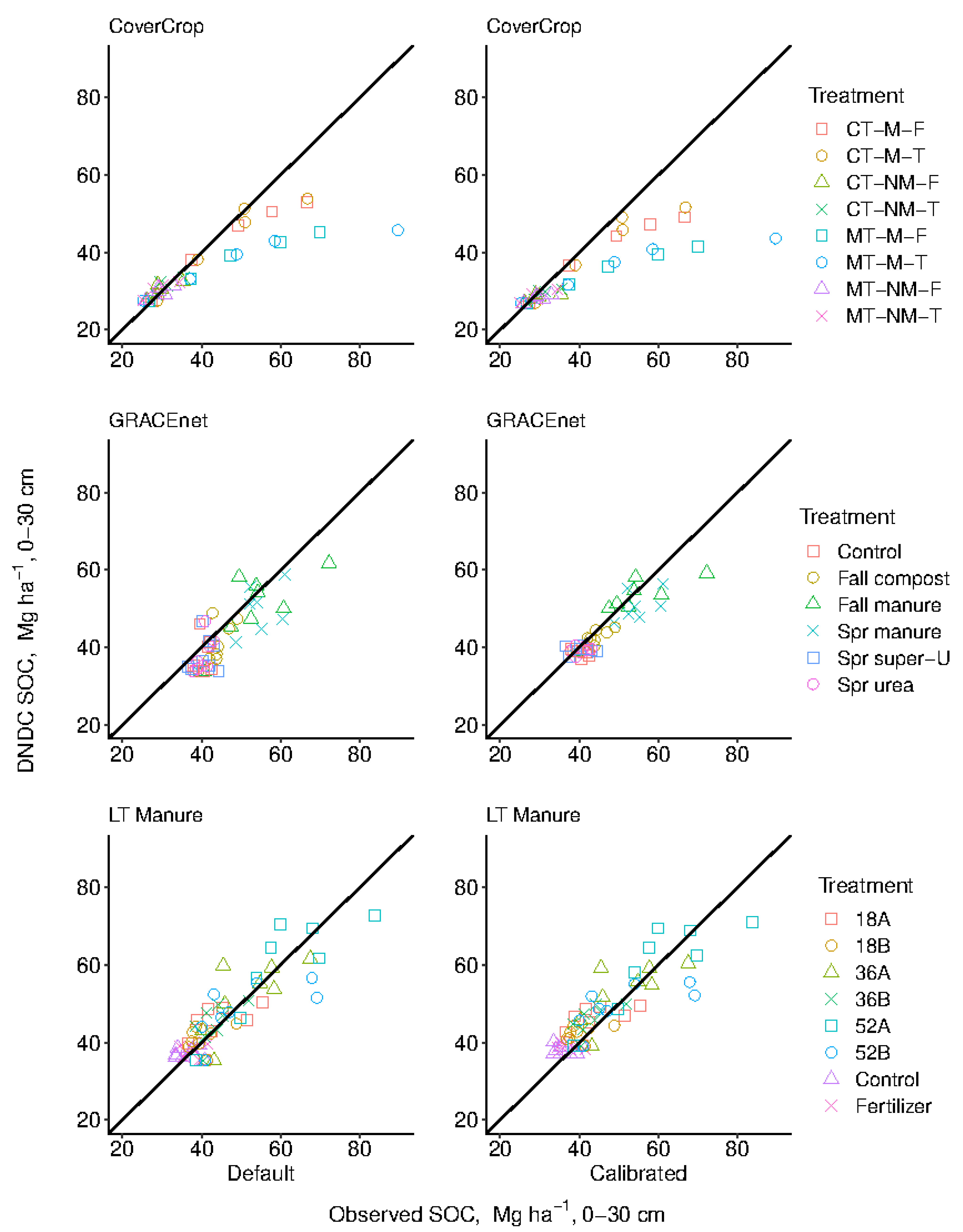
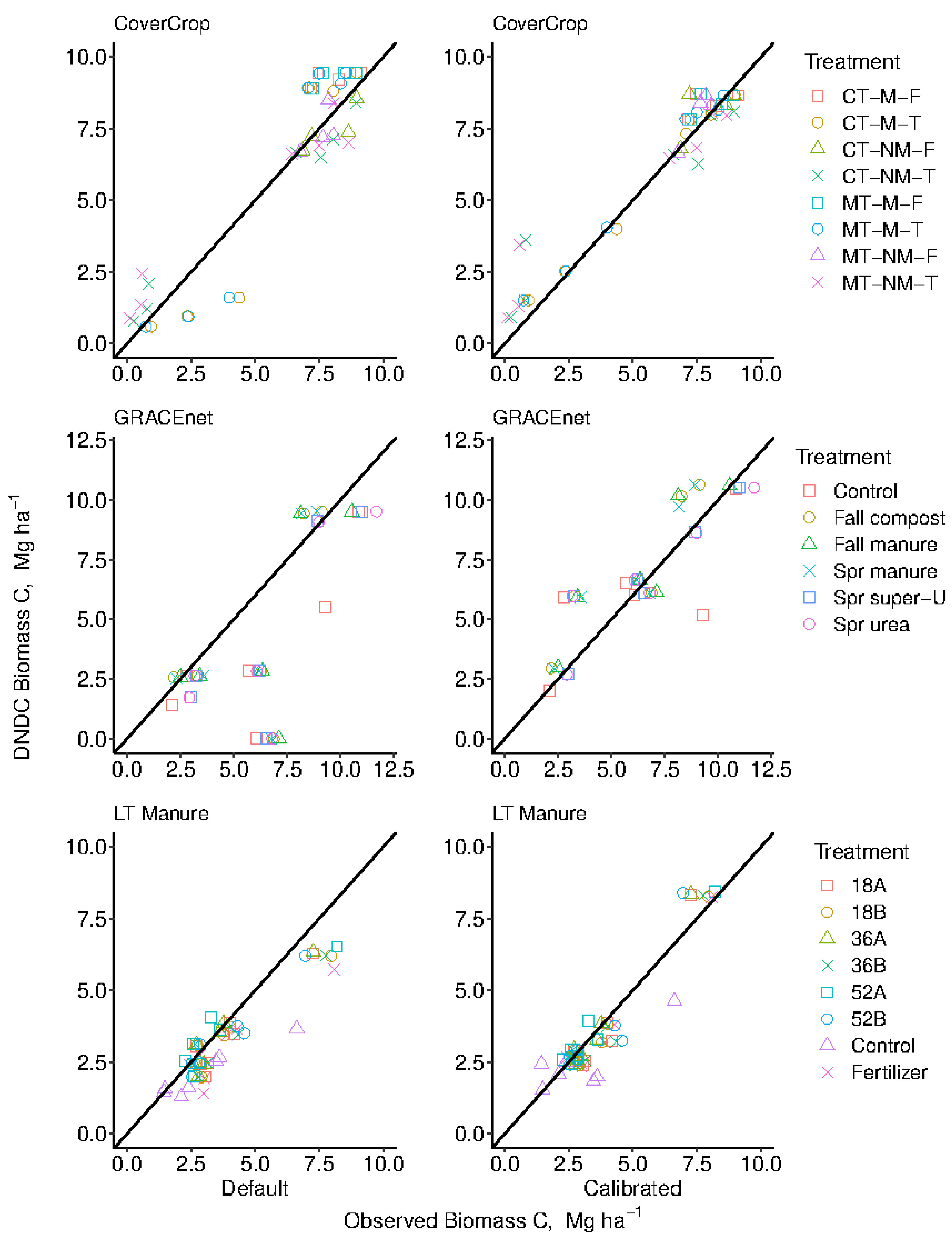
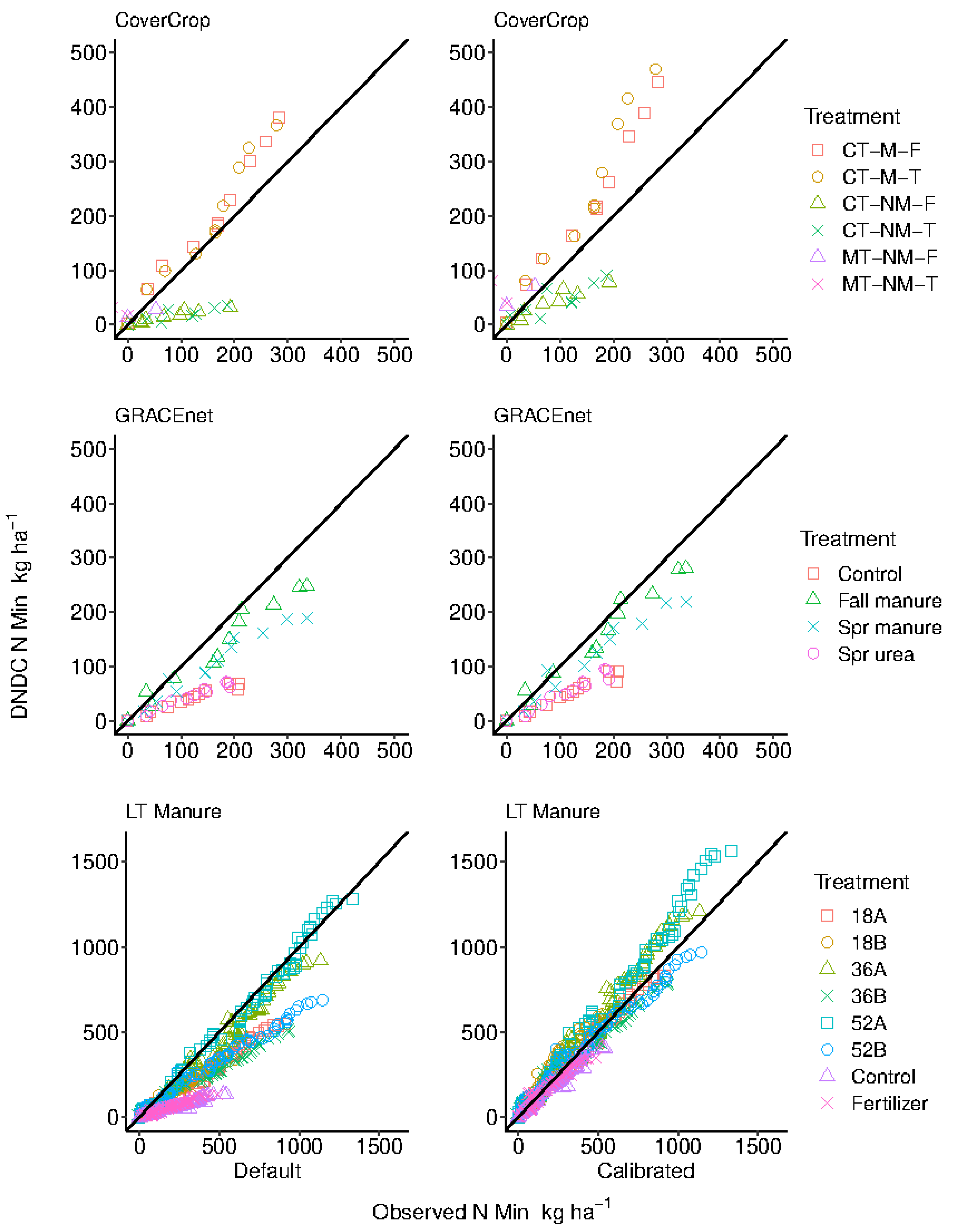
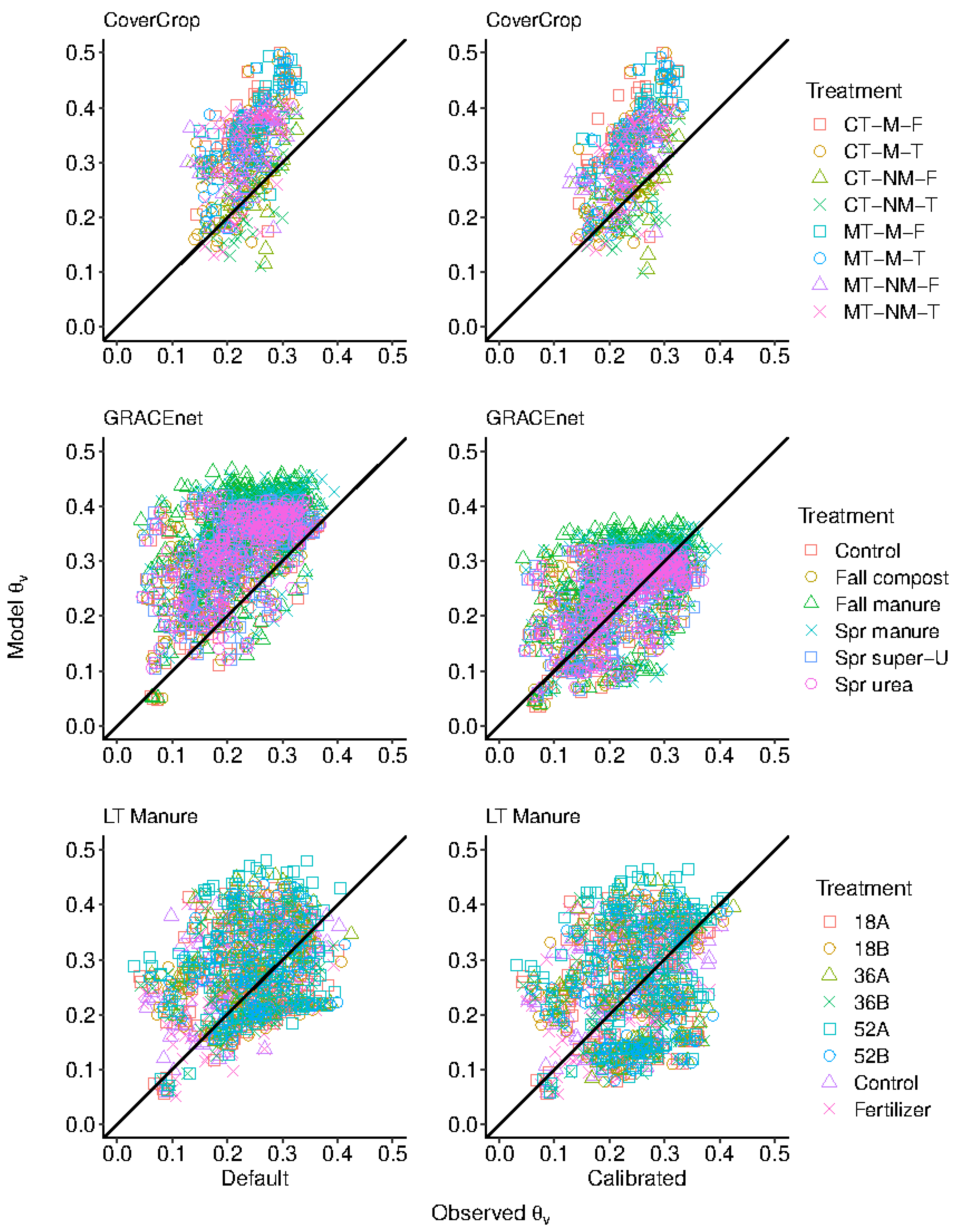
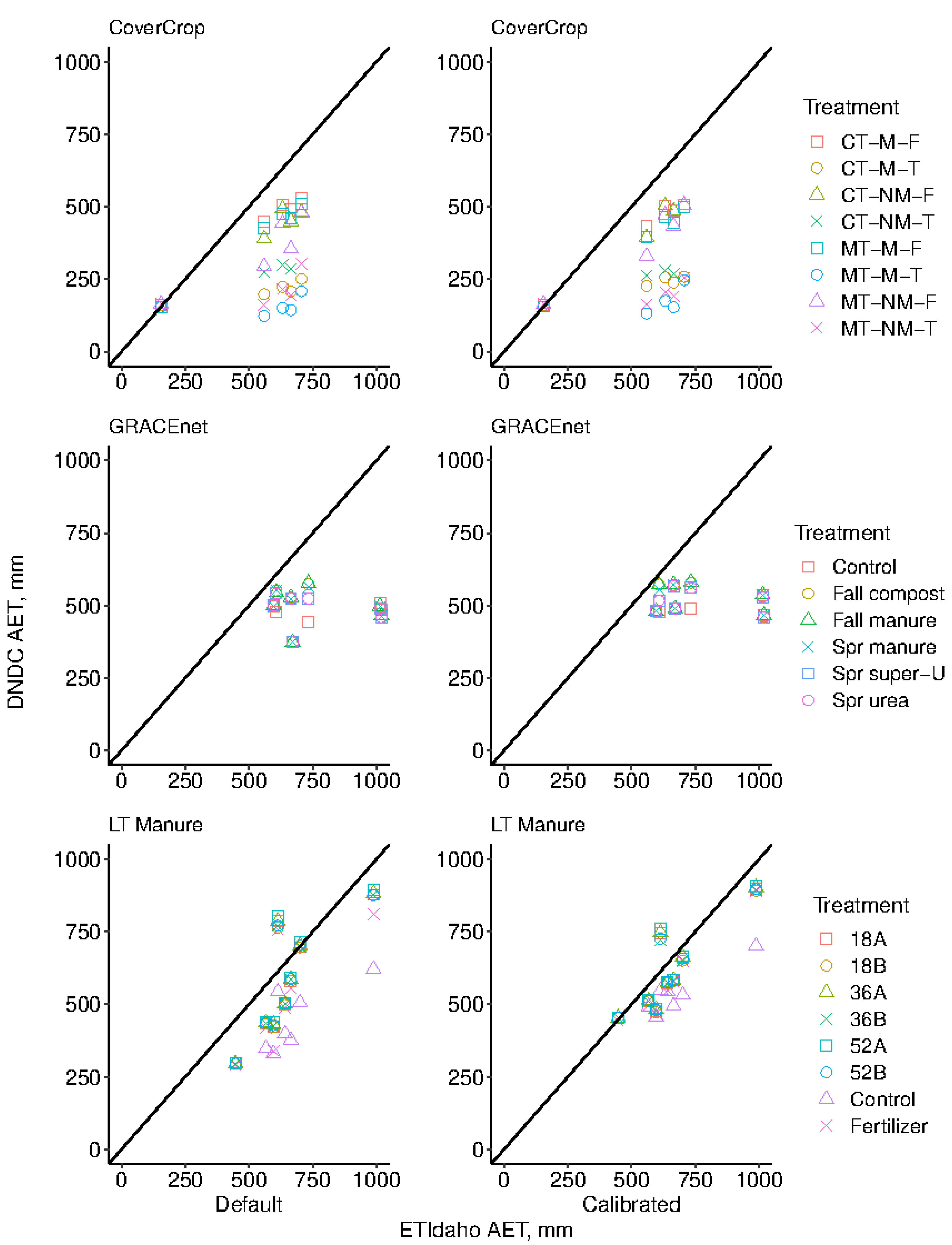
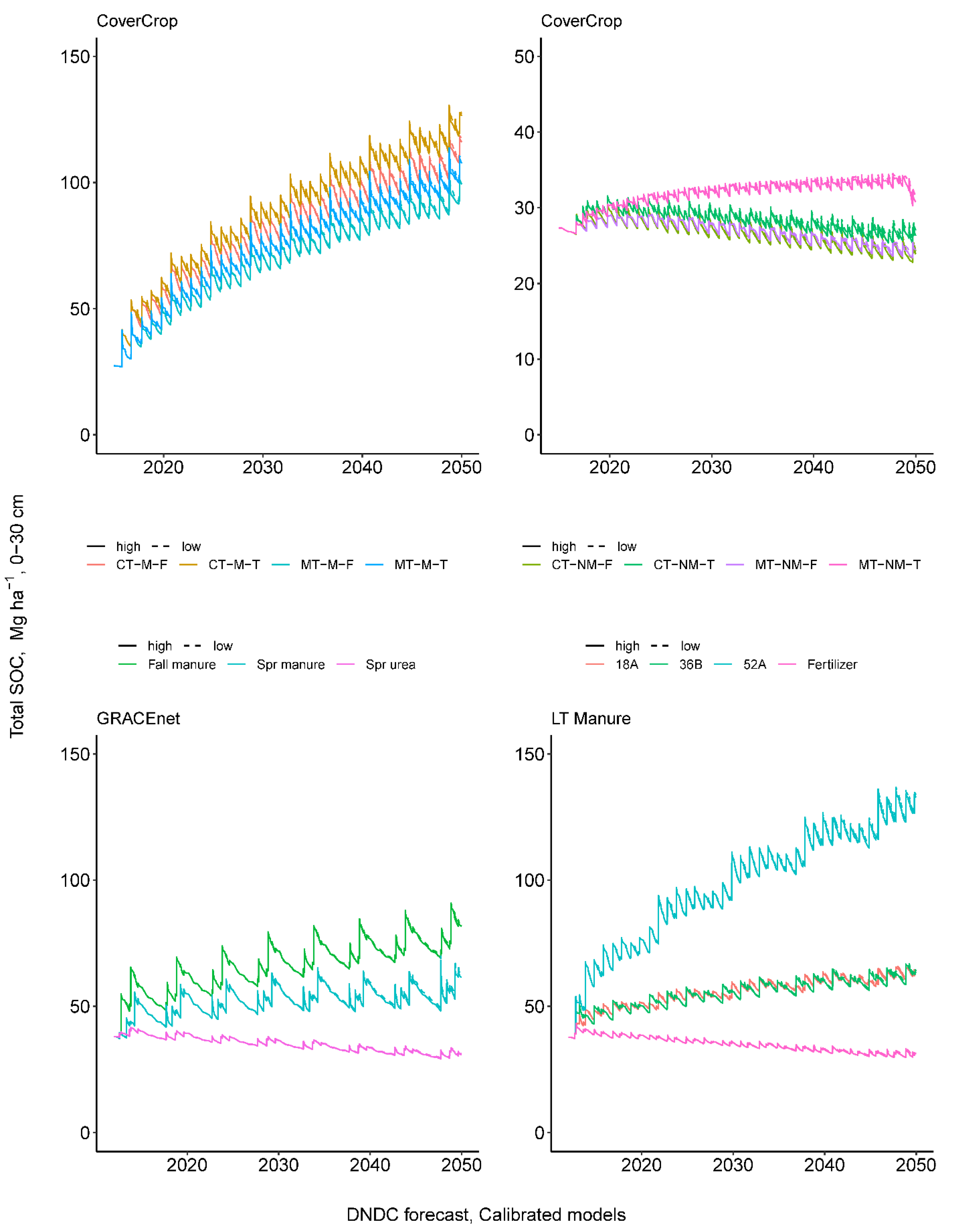
| Total Soil Organic Carbon 0–30 cm | ||||||||
|---|---|---|---|---|---|---|---|---|
| Treatment | 2012 | 2013 | 2014 | 2015 | 2016 | 2017 | 2018 | 2019 |
| ––––––––––––––––––––––––––– Mg ha−1 ––––––––––––––––––––––––––– | ||||||||
| CoverCrop | ||||||||
| CT-M-F | - | - | - | 27.2 a | 37.5 ab | 49.3 a | 57.8 a | 66.5 a |
| CT-M-T | - | - | - | 28.8 a | 39.0 a | 51.0 a | 50.8 a | 66.8 a |
| CT-NM-F | - | - | - | 26.2 a | 28.8 c | 29.8 b | 29.0 b | 35.3 b |
| CT-NM-T | - | - | - | 26.7 a | 28.6 c | 31.4 b | 29.6 b | 35.5 b |
| MT-M-F | - | - | - | 26.8 a | 37.3 ab | 47.2 a | 59.8 a | 69.9 a |
| MT-M-T | - | - | - | 25.2 a | 37.1 ab | 48.9 a | 58.5 a | 89.6 a |
| MT-NM-F | - | - | - | 25.9 a | 30.8 bc | 29.2 b | 29.2 b | 33.0 b |
| MT-NM-T | - | - | - | 25.1 a | 29.2 c | 27.9 b | 30.2 b | 34.4 b |
| p | 0.63 | <0.001 | <0.001 | <0.001 | <0.001 | |||
| GRACEnet | ||||||||
| Control | 38.5 a | 38.1 bc | 37.9 c | 42.5 b | 40.5 b | 39.6 b | 41.8 b | 42.2 c |
| Fall compost | 39.2 a | 42.0 abc | 44.1 b | 43.8 b | 43.8 ab | 42.8 b | 46.9 ab | 49.0 bc |
| Fall manure | 40.5 a | 47.5 ab | 54.2 a | 60.7 a | 52.5 a | 49.5 a | 53.8 a | 72.2 a |
| Spr manure | 39.1 a | 48.7 a | 52.1 a | 60.6 a | 55.2 a | 52.4 a | 54.0 a | 61.1 ab |
| Spr super-U | 44.3 a | 36.6 c | 40.3 bc | 41.9 b | 37.3 b | 40.2 b | 42.9 b | 41.9 c |
| Spr urea | 37.8 a | 41.4 abc | 39.0 c | 40.3 b | 39.1 b | 40.9 b | 41.9 b | 43.0 c |
| p | 0.08 | 0.01 | <0.001 | <0.001 | <0.001 | <0.001 | <0.001 | <0.001 |
| LT manure | ||||||||
| 18A | 40.8 a | 36.6 bcd | 42.5 abc | 51.5 abc | 38.9 bc | 45.3 bcd | 41.6 b | 55.4 bc |
| 18B | 41.4 a | 39.4 abcd | 36.8 bc | 42.4 cd | 37.5 bc | 38.6 de | 37.8 b | 48.8 c |
| 36A | 43.2 a | 40.3 abcd | 45.9 ab | 58.3 ab | 54.8 a | 57.7 ab | 45.5 ab | 67.5 ab |
| 36B | 40.4 a | 43.9 abc | 40.9 bc | 45.3 bcd | 38.4 bc | 44.2 cd | 41.2 b | 51.9 c |
| 52A | 38.7 a | 49.9 a | 53.9 a | 69.7 a | 57.5 a | 67.9 a | 59.8 a | 83.7 a |
| 52B | 40.9 a | 44.9 ab | 40.0 bc | 69.2 a | 47.0 ab | 54.0 abc | 43.1 ab | 67.9 ab |
| Control | 40.9 a | 33.5 d | 35.3 c | 37.4 d | 33.5 c | 34.0 e | 37.7 b | 39.4 d |
| Fertilizer | 39.3 a | 35.3 cd | 35.4 c | 37.8 d | 34.7 c | 34.5 e | 37.9 b | 41.5 d |
| p | 0.29 | <0.001 | <0.001 | <0.001 | <0.001 | <0.001 | <0.001 | <0.001 |
| Applied Manure-C | Biomass-C Removed | |||||||||||||||||
|---|---|---|---|---|---|---|---|---|---|---|---|---|---|---|---|---|---|---|
| 2012 | 2013 | 2014 | 2015 | 2016 | 2017 | 2018 | 2019 | Cumulative | 2012 | 2013 | 2014 | 2015 | 2016 | 2017 | 2018 | 2019 | Cumulative | |
| CoverCrop | ––––––––––––––––––––––––––– Mg ha–1 ––––––––––––––––––––––––––– | |||||||||||||||||
| CT-M-F | - | - | - | 14.92 | 16.70 | 9.17 | 8.88 | 10.84 | 60.51 | - | - | - | - | 8.26 | 9.12 | 7.46 | 7.19 | 32.03 |
| CT-M-T | - | - | - | 14.30 | 17.16 | 9.25 | 8.19 | 10.83 | 59.73 | - | - | - | - | 8.06 | 13.35 | 8.03 | 9.61 | 39.05 |
| CT-NM-F | - | - | - | - | - | - | - | - | - | - | - | - | - | 8.64 | 8.97 | 7.22 | 6.86 | 31.69 |
| CT-NM-T | - | - | - | - | - | - | - | - | - | - | - | - | - | 8.04 | 9.77 | 7.80 | 7.36 | 32.98 |
| MT-M-F | - | - | - | 14.72 | 16.94 | 9.00 | 8.18 | 10.85 | 59.68 | - | - | - | - | 8.47 | 8.96 | 7.64 | 7.26 | 32.32 |
| MT-M-T | - | - | - | 15.50 | 17.45 | 9.89 | 8.56 | 10.84 | 62.24 | - | - | - | - | 8.34 | 12.54 | 8.24 | 9.45 | 38.57 |
| MT-NM-F | - | - | - | - | - | - | - | - | - | - | - | - | - | 8.06 | 7.87 | 7.65 | 6.76 | 30.33 |
| MT-NM-T | - | - | - | - | - | - | - | - | - | - | - | - | - | 8.65 | 8.67 | 7.61 | 6.98 | 31.91 |
| GRACEnet | ||||||||||||||||||
| Control | - | - | - | - | - | - | - | - | - | - | 9.29 | 3.72 | 2.79 | 5.67 | 6.08 | 10.84 | - | 38.39 |
| Fall compost | 2.98 | 3.38 | - | - | - | 3.30 | 1.78 | - | 11.45 | - | 8.28 | 4.29 | 3.30 | 6.28 | 6.88 | 9.13 | - | 38.16 |
| Fall manure | 15.97 | 15.45 | - | - | - | 9.26 | 7.99 | - | 48.67 | - | 8.13 | 6.21 | 3.41 | 6.34 | 7.12 | 10.54 | - | 41.75 |
| Spr manure | - | 7.93 | 13.22 | - | - | - | 5.10 | 10.06 | 36.30 | - | 8.18 | 4.99 | 3.56 | 6.20 | 6.78 | 8.91 | - | 38.61 |
| Spr super-U | - | - | - | - | - | - | - | - | - | - | 8.91 | 5.77 | 3.24 | 6.24 | 6.54 | 10.99 | - | 41.69 |
| Spr urea | - | - | - | - | - | - | - | - | - | - | 9.00 | 6.06 | 3.17 | 6.08 | 6.80 | 11.69 | - | 42.78 |
| LT manure | ||||||||||||||||||
| 18A | 4.94 | 6.40 | 3.75 | 4.02 | 3.37 | 2.80 | 2.17 | 2.10 | 29.54 | - | 2.90 | 4.01 | 6.20 | 7.26 | 5.64 | 4.18 | 6.63 | 36.81 |
| 18B | 4.94 | - | 3.75 | - | 3.37 | - | 2.17 | - | 14.22 | - | 2.66 | 4.02 | 6.14 | 7.96 | 5.58 | 3.80 | 6.29 | 36.46 |
| 36A | 9.94 | 12.89 | 7.54 | 8.10 | 6.78 | 5.63 | 4.36 | 4.23 | 59.46 | - | 3.01 | 3.78 | 6.38 | 7.27 | 5.13 | 3.62 | 6.53 | 35.71 |
| 36B | 9.94 | - | 7.54 | - | 6.78 | - | 4.36 | - | 28.61 | - | 2.55 | 4.00 | 6.24 | 7.76 | 5.82 | 4.34 | 6.70 | 37.41 |
| 52A | 14.87 | 19.30 | 11.29 | 12.12 | 10.14 | 8.43 | 6.53 | 6.33 | 89.00 | - | 2.83 | 3.26 | 6.92 | 8.20 | 5.57 | 3.64 | 5.61 | 36.03 |
| 52B | 14.87 | - | 11.29 | - | 10.14 | - | 6.53 | - | 42.83 | - | 2.52 | 4.30 | 6.79 | 6.96 | 5.83 | 4.59 | 6.05 | 37.04 |
| Control | - | - | - | - | - | - | - | - | - | - | 2.40 | 3.61 | 3.90 | 6.63 | 2.78 | 3.47 | 2.95 | 25.74 |
| Fertilizer | - | - | - | - | - | - | - | - | - | - | 2.43 | 4.29 | 5.65 | 8.08 | 5.82 | 3.89 | 5.72 | 35.88 |
| Slope | ||||
|---|---|---|---|---|
| Treatment | Estimate | C.I. 2.5% | C.I. 97.5% | p > F |
| CoverCrop | ––––––––––––––––––––––– Mg ha–1 year−1 –––––––––––––––––––––– | |||
| CT-M-F | 9.9 | 8.1 | 11.7 | <0.001 |
| CT-M-T | 8.8 | 7.0 | 10.6 | <0.001 |
| CT-NM-F | 1.8 | 0.8 | 2.9 | <0.010 |
| CT-NM-T | 1.9 | 0.8 | 2.9 | <0.010 |
| MT-M-F | 10.9 | 8.3 | 13.4 | <0.001 |
| MT-M-T | 15.0 | 12.2 | 17.8 | <0.001 |
| MT-NM-F | 1.2 | 0.3 | 2.2 | <0.050 |
| MT-NM-T | 1.9 | 1.2 | 2.7 | <0.001 |
| GRACEnet | ||||
| Control | 0.6 | <0.1 | 1.1 | <0.050 |
| Fall compost | 1.1 | 0.6 | 1.6 | <0.001 |
| Fall manure | 2.8 | 1.4 | 4.1 | <0.001 |
| Spr manure | 2.1 | 1.3 | 2.9 | <0.001 |
| Spr super-U | 0.1 | –0.5 | 0.8 | 0.719 |
| Spr urea | 0.5 | 0.1 | 0.9 | <0.050 |
| LT manure | ||||
| 18A | 1.5 | 0.5 | 2.4 | <0.010 |
| 18B | 0.5 | –0.3 | 1.3 | 0.188 |
| 36A | 2.7 | 1.3 | 4.1 | <0.001 |
| 36B | 0.8 | 0.0 | 1.7 | 0.061 |
| 52A | 4.7 | 3.1 | 6.3 | <0.001 |
| 52B | 2.4 | 0.7 | 4.0 | <0.010 |
| Control | 0.0 | –0.6 | 0.7 | 0.905 |
| Fertilizer | 0.3 | –0.2 | 0.7 | 0.273 |
| PBIAS | NSE | MAE | ||||
|---|---|---|---|---|---|---|
| Default | Calibrated | Default | Calibrated | Default | Calibrated | |
| ––––––––––––––––– Soil Organic Carbon, Mg ha−1 ––––––––––––––––– | ||||||
| CoverCrop | −9.8 | −14.4 | 0.59 | 0.48 | 5.08 | 6.06 |
| GRACEnet | −6.9 | −3.9 | 0.45 | 0.76 | 4.74 | 2.75 |
| LT manure | 0.6 | 2.9 | 0.74 | 0.73 | 4.12 | 4.36 |
| –––––––––––––––– Biomass Carbon (yield), Mg ha−1 –––––––––––––––– | ||||||
| CoverCrop | 4.1 | 5.0 | 0.84 | 0.92 | 0.99 | 0.58 |
| GRACEnet | −32.6 | 8.3 | −0.69 | 0.70 | 2.62 | 1.13 |
| LT manure | −14.4 | −4.4 | 0.73 | 0.85 | 0.67 | 0.49 |
| –––––––––––––––– Nitrogen Mineralization, kg ha−1 –––––––––––––––– | ||||||
| CoverCrop | −10.0 | 20.2 | 0.37 | 0.13 | 51 | 61 |
| GRACEnet | −42.4 | −33.7 | 0.33 | 0.54 | 59 | 48 |
| LT manure | −30.9 | 6.2 | 0.70 | 0.92 | 121 | 59 |
| ––––––––––––––––––––––– Soil Water, Θv ––––––––––––––––––––––– | ||||||
| CoverCrop | 34.1 | 27.9 | −4.72 | −3.49 | 0.09 | 0.08 |
| GRACEnet | 46.1 | 9.4 | −2.03 | −0.03 | 0.11 | 0.06 |
| LT manure | 14.3 | 4.2 | −0.73 | −1.07 | 0.08 | 0.09 |
| –––––––––––– Estimated Actual Evapotranspiration, mm –––––––––––– | ||||||
| CoverCrop | −44.5 | −43.7 | −1.17 | −1.11 | 244 | 240 |
| GRACEnet | −37.4 | −34.0 | −1.92 | −1.55 | 303 | 275 |
| LT manure | −14.3 | −7.9 | 0.25 | 0.59 | 150 | 80 |
Publisher’s Note: MDPI stays neutral with regard to jurisdictional claims in published maps and institutional affiliations. |
© 2021 by the authors. Licensee MDPI, Basel, Switzerland. This article is an open access article distributed under the terms and conditions of the Creative Commons Attribution (CC BY) license (http://creativecommons.org/licenses/by/4.0/).
Share and Cite
Bierer, A.M.; Leytem, A.B.; Dungan, R.S.; Moore, A.D.; Bjorneberg, D.L. Soil Organic Carbon Dynamics in Semi-Arid Irrigated Cropping Systems. Agronomy 2021, 11, 484. https://doi.org/10.3390/agronomy11030484
Bierer AM, Leytem AB, Dungan RS, Moore AD, Bjorneberg DL. Soil Organic Carbon Dynamics in Semi-Arid Irrigated Cropping Systems. Agronomy. 2021; 11(3):484. https://doi.org/10.3390/agronomy11030484
Chicago/Turabian StyleBierer, Andrew M., April B. Leytem, Robert S. Dungan, Amber D. Moore, and David L. Bjorneberg. 2021. "Soil Organic Carbon Dynamics in Semi-Arid Irrigated Cropping Systems" Agronomy 11, no. 3: 484. https://doi.org/10.3390/agronomy11030484
APA StyleBierer, A. M., Leytem, A. B., Dungan, R. S., Moore, A. D., & Bjorneberg, D. L. (2021). Soil Organic Carbon Dynamics in Semi-Arid Irrigated Cropping Systems. Agronomy, 11(3), 484. https://doi.org/10.3390/agronomy11030484






